France & Spain’s Top Prehistoric Cave Art Sites
Sometimes we measure our travels in distance.
Other times, we measure our travels in time, as in traveling back millenia to a time before recorded history.
That’s when we head to France & Spain, to be awed and humbled by some of Europe’s most breathtaking prehistoric cave art.
Why Visiting Cave Art Is A Must
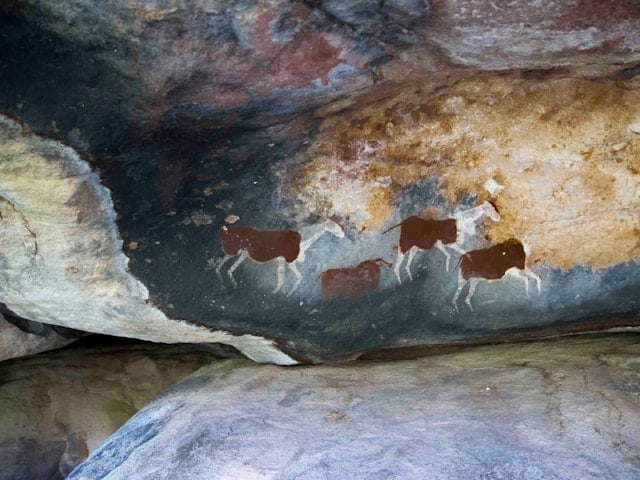
Cave paintings are literally Chapter One in the story of human art self-expression.
For a quick dose of perspective, cave art is five times older than the Pyramids of Giza.
Cave paintings exist on every continent, proof that early on, primitive cultures around the world, thousands of years away from knowing of each other’s existence, connected to one another in their most basic needs to communicate and express themselves.
Entering into these same hallowed spaces, standing before the same walls our prehistoric ancestors stood before, and beholding their earliest known attempts at self-expression is one of the most moving experiences travel has to offer.
These ancient artworks, painted onto and etched into the walls of hidden caves across Europe and predating the written world by thousands of years, offer us a rare glimpse into the minds of our distant ancestors and the opportunity to connect with them across the ages.
Whether you’re an art enthusiast, history buff, or simply an explorer at heart, these caves should be at the top of your travel must-do list.
In this blog, we’ll provide a guide to the best cave paintings in France and the top cave paintings in Spain, as well as some historical perspective that will make your visit as meaningful and, I hope, awe-inspiring.
I’ve also put together a comprehensive reading list and provided some helpful links as you plan your journey to these iconic destinations.
Who Painted Europe’s Cave Paintings and Why?
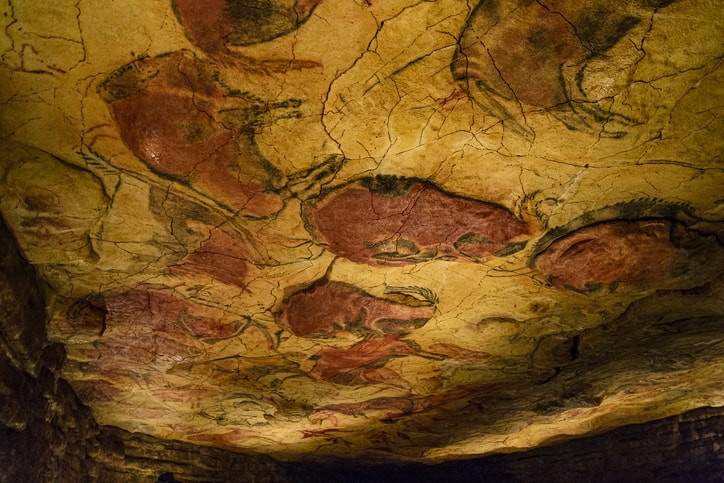
While we’ve made significant strides in understanding these artworks, many mysteries remain. Who were the artists? What motivated them? How did they create such vivid and lasting images in the depths of dark caves?
To help prepare you for your explorations, here’s a quick fact sheet on the top cave paintings in France and Spain.
Artists:
The identity of the artists who created cave paintings remains largely unknown.
They were likely members of prehistoric societies, and while we know some details of what their lives might have been like, they live millenia before the written word, and so their identities will forever remain a mystery.
Geological Era:
Cave paintings date back to the Upper Paleolithic period, which spans from approximately 40,000 to 10,000 years ago.
They are among the oldest known forms of artistic expression.
Themes:
Cave art across Europe shares remarkably common themes.
These artworks often depict scenes of hunting, animals, human figures, and abstract symbols. These themes provide insights into the daily lives, rituals, and beliefs of prehistoric societies.
Purpose:
The exact purpose of cave paintings is still debated among scholars.
They may have served as a form of communication, storytelling, ritualistic or spiritual expression, or even as instructional aids for hunting.
Locations:
Cave art can be found on every inhabited continent, with notable examples in Europe, Asia, Africa, and the Americas. Some of the most famous sites are located in France and Spain.
Ink and Pigments:
Cave paintings were created using a variety of natural materials, such as minerals, plant extracts, and animal fats, which were all used to make pigments.
These pigments were then applied to cave walls using brushes, fingers, or other tools.
Techniques:
Prehistoric artists used various techniques to create cave paintings, including stenciling, finger painting, and using brushes made from animal hair.
They employed shading, blending, and contouring to add depth and dimension to their artwork.
Discovery:
Many cave paintings were discovered relatively recently in the modern era, often by explorers, archaeologists, or local inhabitants.
Some caves remained hidden and undisturbed for tens of thousands of years.
How Can I Visit Spain and France’s Cave Art?
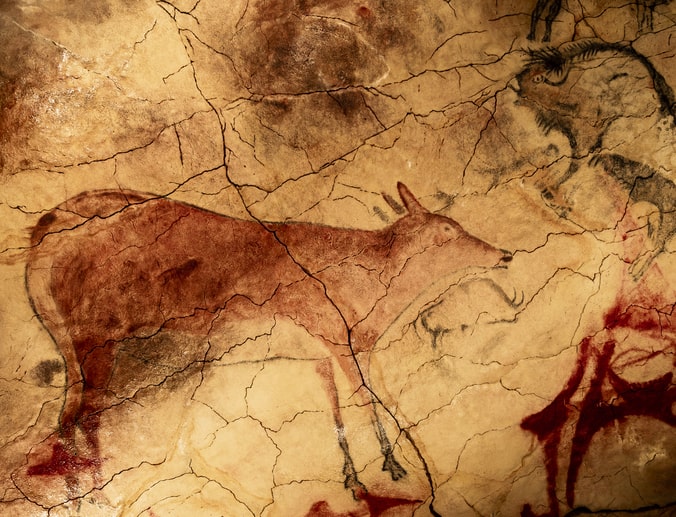
The value of these ancient treasures is inestimable. Their fragility is equally staggering, threatened daily by moisture, temperature fluctuations, and human impact.
So, how do we experience them and at the same time honor our desire to preserve and protect them?
Thankfully, in some cases archaeologists and conservationists have crafted experiences that protect the artworks while allowing us to observe the original art.
In situations where the environment is too fragile to accommodate tourism, highly accurate reproductions have been created in nearby caves dating from the same epoch.
In both cases, the experience of visiting these sites is deeply moving.
Below is a summary of Europe’s Top Seven Cave paintings. I’ve noted those which allow visitors to view original art, and those which allow visitors to experience superb recreations.
Note that most require reservations prior to arrival, and many offer guided tours, which are recommended to truly experience the wonder of these ancient sites.
1. Lascaux Cave (France)
History:
Perhaps the world’s best known cave paintings, the Lascaux Cave in Southern France was discovered improbably enough in 1940 by four teenagers following their lost dog, “Robot” into a cave in the countryside.
Lascaux houses some of the world’s most famous Paleolithic cave paintings, dating back approximately 17,000 years.
The original cave is closed to the public, but “Lascaux IV,” a meticulous replica at the Lascaux International Center for Cave Art, offers visitors a chance to experience the awe-inspiring artwork and attend lectures, tours and demonstrations. The center is a sprawling complex with a comprehensive set of excellent exhibits, tours, and educational materials.
Unique Features:
The paintings at Lascaux feature intricate depictions of animals, including horses, bison, and a remarkable bull. The level of detail and artistry displayed in these works is breathtaking, making Lascaux a must-visit for anyone interested in prehistoric art.
Learn more and plan your visit here:

https://www.lascaux.fr/frhttps://www.lascaux.fr/fr
2. Chauvet-Pont-d’Arc Cave (France)
History:
The Chauvet-Pont-d’Arc Cave is home to some of the oldest known cave paintings, dating back over 30,000 years. Discovered in 1994, it contains remarkable artwork, including lifelike depictions of animals like lions, mammoths, and rhinoceroses.
Visitors can visit two authentic reproductions, The Grotte Chauvette, which is a meticulously detailed immersive experience that reproduces the sights, sounds, and smells of the cave, and the Aurignacian Gallery, which delves into the art, culture, and science of the cave.
Unique Features:
The art in Chauvet-Pont-d’Arc Cave is characterized by its incredible detail and sophistication. The artists used a variety of techniques to bring the animals to life, including shading and contouring, earning this designation as a UNESCO World Heritage site.
Learn more and plan your visit here:
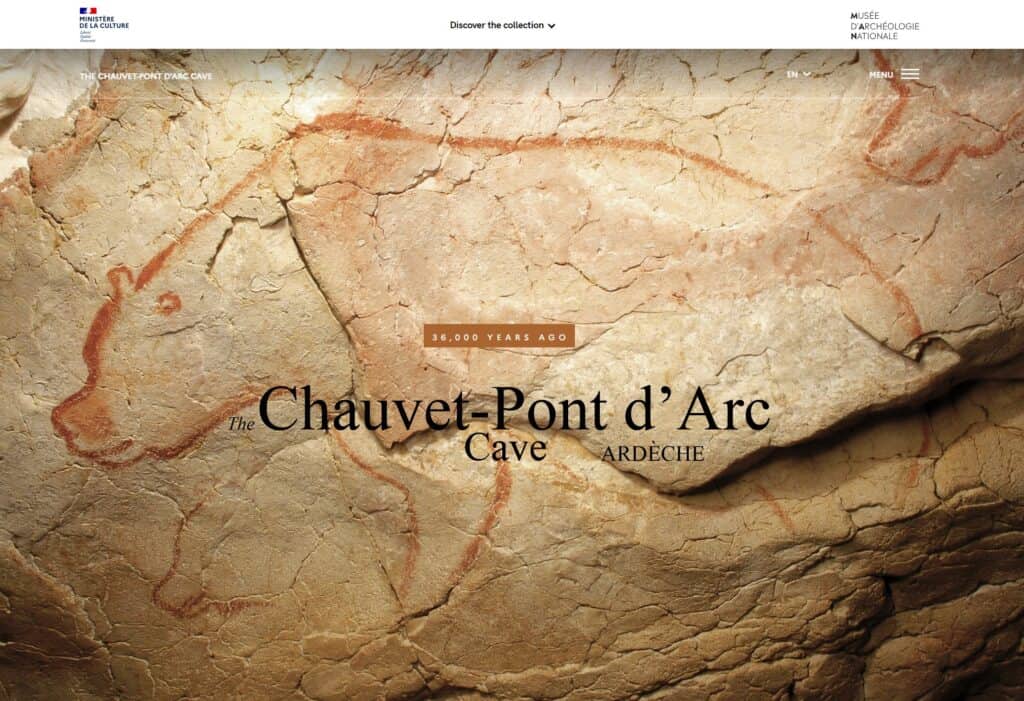
https://archeologie.culture.gouv.fr/chauvet/en
3. Altamira Cave (Spain)
History:
Altamira Cave, located in northern Spain, boasts stunning Paleolithic art, including paintings of bison, horses, and other animals. The cave was discovered in 1879, and its art dates back approximately 14,000 years.
Unique Features:
What sets Altamira apart is its lifelike and vibrant representations of animals. The cave’s artwork is renowned for its use of perspective and the artists’ skill in capturing the essence of the animals they painted.
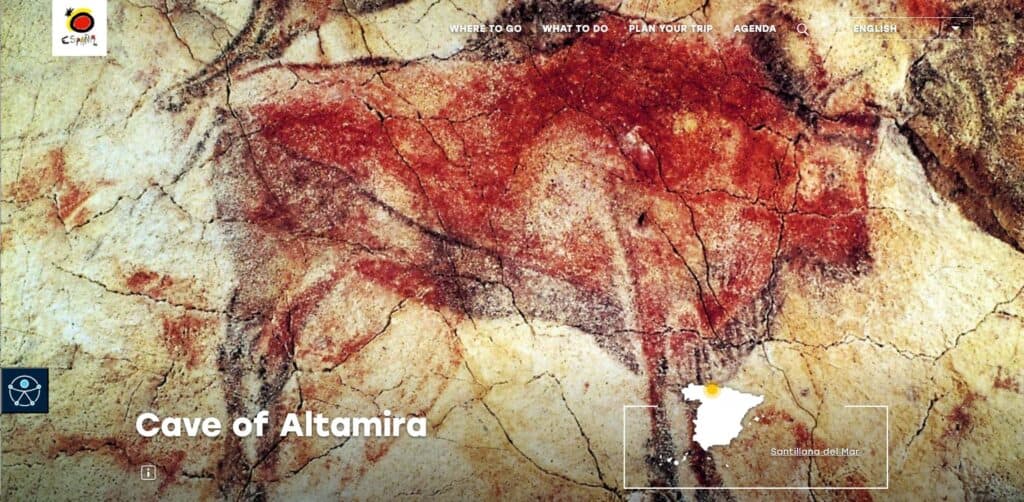
https://www.spain.info/en/places-of-interest/caves-altamira/
4. Niaux Cave (France)
History:
Niaux Cave, nestled in the French Pyrenees, features prehistoric cave art from the Magdalenian period, approximately 14,000 years ago.
Covering over two kilometers, this underground complex contains low vaults, vaults that soar over tens of meters high, and underground lakes. Visitors who take the approximately two hour tour of this fascinating site have the rare opportunity to explore some of its chambers and view ancient artwork firsthand.
Unique Features:
Niaux Cave is known for its over seven hundred intricate drawings of bison and other animals. The artists skillfully utilized the contours and shapes of the cave walls to enhance the realism of their creations.
Learn more and plan your visit here:
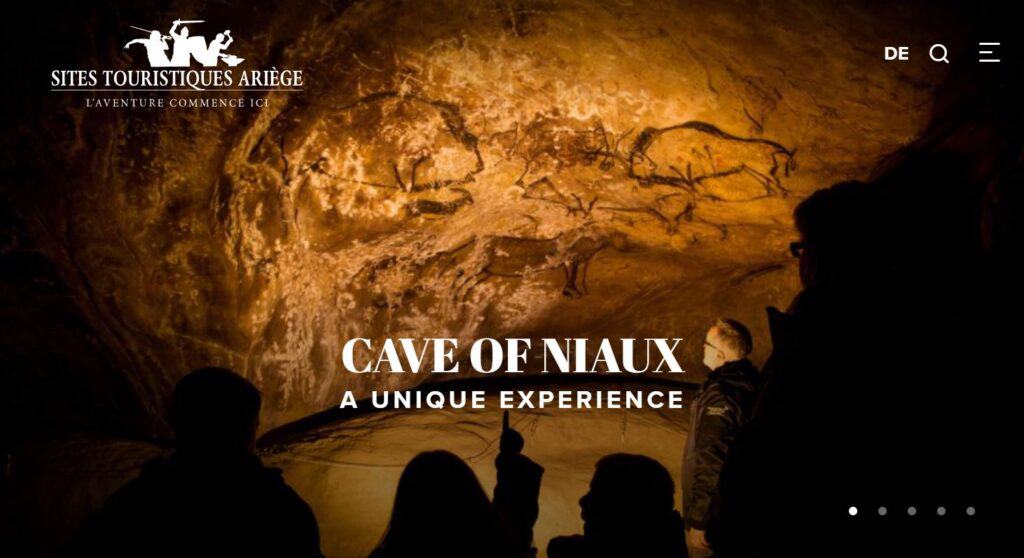
https://www.sites-touristiques-ariege.fr/en/grotte-de-niaux/
5. Font-de-Gaume Cave (France)
History:
Font-de-Gaume Cave, located in the Dordogne region of France, features prehistoric paintings, including depictions of bison, mammoths, and reindeer. It’s one of the few caves in France where original artwork is still visible to the public.
Its most well-known image is the iconic Bison Frieze, found in the chamber of the Bisons, which depicts 13 Bison in an eclectic layout.
Unique Features:
The cave’s approximately 250 images are not only detailed but also exhibit a rich use of color. It’s “Licking Reindeer” image is a uniquely emotional depiction for the era, showing a male deer kneeling to lick the head of a female reindeer.
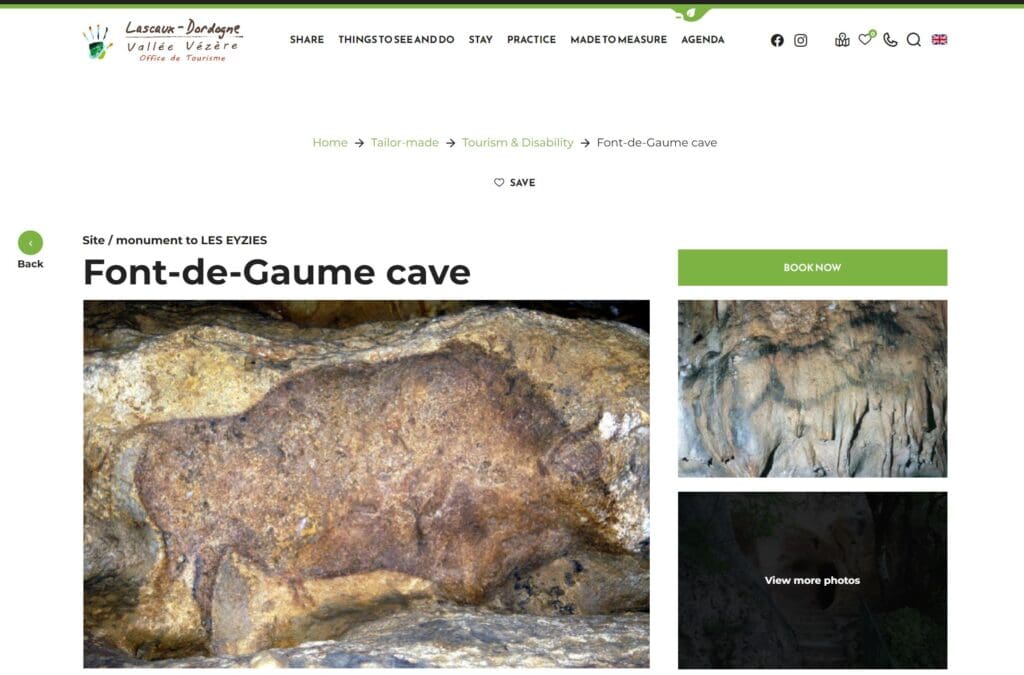
6. Pech Merle Cave (France)
History:
Pech Merle Cave, situated in Cabrerets in the Lot region of France, contains a variety of prehistoric paintings, including handprints, animals, and geometric designs.
Paintings here date back a remarkable 29,000 or more years. The site is home to over 800 artistic representations,
Discovered in 1922 by three children from the nearby village of Cabrerets, this cave is also notable for its unique geological features, which formed over several million years.
Unique Features:
Pech Merle stands out for its intriguing handprints, which offer a personal connection to the ancient artists. The cave also features stunning depictions of animals, including horses and mammoths.
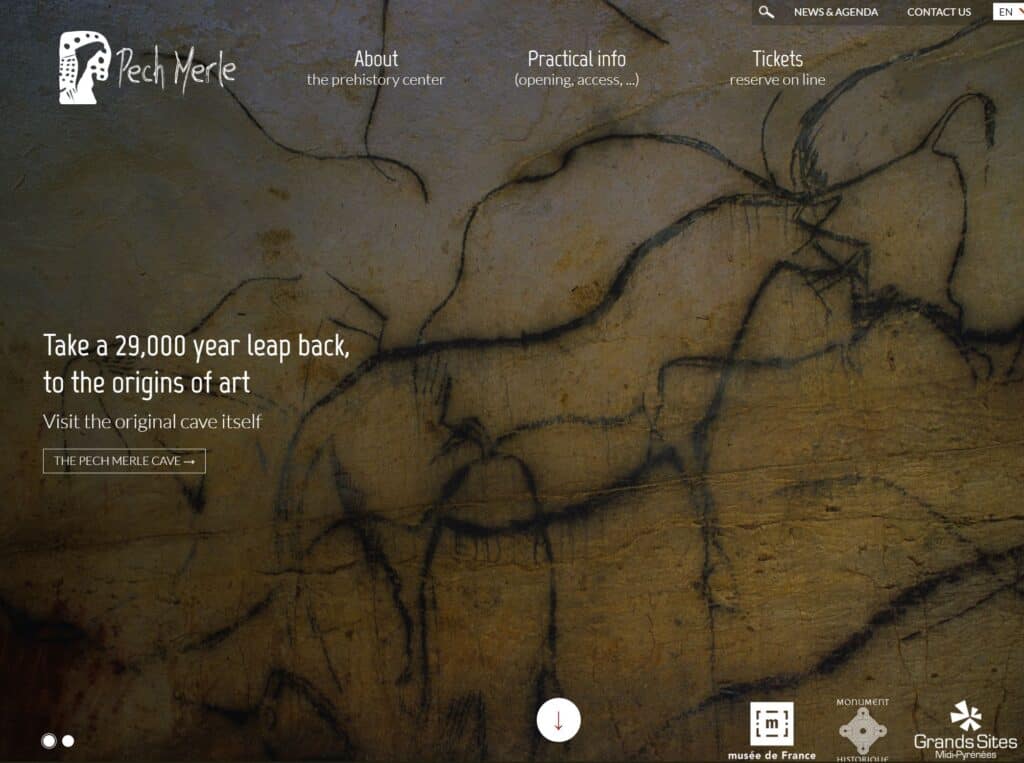
7. Tito Bustillo Cave (Spain)
History:
Tito Bustillo Cave in the town of Ribadesella in Asturias, Spain, features prehistoric art, including depictions of animals and human figures. It is considered to be one of the most important cave collections of Paleolithic cave art in Europe.
Discovered in 1968, the art on its walls was created between 22,000 and 10,000 years ago. The art within the cave’s gallery is organized into 11 unique sets.
The adjoining Adrines Cave is also a spectacular attraction. The nearby Tito Bustillo Centre of Rock and Cave art is an excellent museum with exhibits on Asturian prehistory and archeology.
Unique Features:
The art at Tito Bustillo Cave is known for its intricate representations of the female body. Images of horses and reindeer are also notable here.. The cave’s setting along the Sella River adds to its charm.
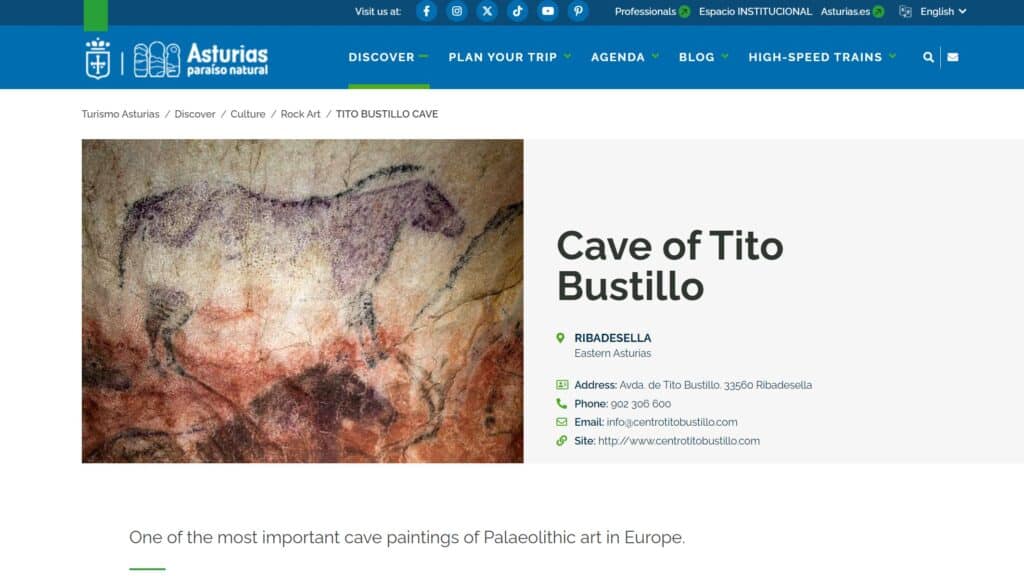
https://www.turismoasturias.es/en/descubre/cultura/arte-rupestre/rupestre-cueva-de-tito-bustillo
How Can I Learn More About Europe’s Cave Paintings?
Below are our top eight recommended books on cave paintings and prehistoric art that will elevate your travels as you explore these wonders of the prehistoric world.
1. “The Mind in the Cave: Consciousness and the Origins of Art” by David Lewis-Williams
This book explores the connection between cave art and the development of human consciousness, offering insights into the meaning and purpose of prehistoric cave paintings.
2. “What Is Paleolithic Art?” by Jean Clottes
Written by one of the foremost experts on cave art, Jean Clottes, this book provides a comprehensive overview of prehistoric art, its history, and its cultural significance.
3. “The Cave Painters: Probing the Mysteries of the World’s First Artists” by Gregory Curtis
In this engaging book, Gregory Curtis takes readers on a journey to various cave art sites around the world, exploring the lives and motivations of the ancient artists.
4. “Dawn of Art: The Chauvet Cave” by Jean-Marie Chauvet, Eliette Brunel Deschamps, and Christian Hillaire
This book focuses on the discovery of the Chauvet-Pont-d’Arc Cave in France and the remarkable art found within. It includes beautiful illustrations and photographs of the cave’s artwork.
5. “The First Artists: In Search of the World’s Oldest Art” by Michel Lorblanchet
Michel Lorblanchet examines the world’s oldest art and the context in which it was created, shedding light on the lives of our ancient ancestors and the significance of their artistic expressions.
6. “The Nature of Paleolithic Art” by R. Dale Guthrie
This book offers a scientific perspective on Paleolithic art, exploring the materials and techniques used by prehistoric artists and the environmental factors that influenced their work.
7. “Stepping-Stones: A Journey through the Ice Age Caves of the Dordogne” by Christine Desdemaines-Hugon
Christine Desdemaines-Hugon is an unrivaled expert in the cave art and artists of the Dordogne region. In this book she combines her expertise in both art and archaeology to convey an intimate understanding of the “cave experience.”



